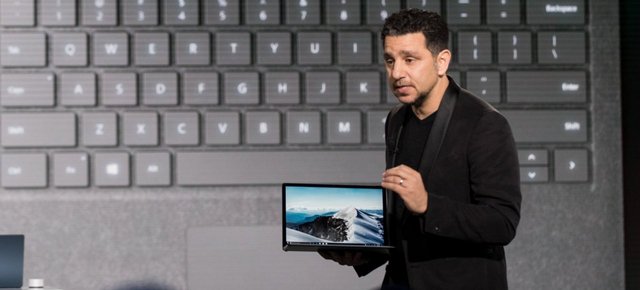1 Public Speaking Skill You Can Learn From Microsoft's Best Presenter

Microsoft vice president Panos Panay oversees the company's hardware products, from Surface to Xbox. After his keynotes and product demonstrations, audience members often post positive feedback on Twitter about the presentation itself. "Passion" is one of the most common words they use to describe him.
For example, after Panay recently unveiled the new Surface Pro With LTE, a mobile laptop/tablet available to business customers in December, fans expressed their excitement on Twitter. Some of the comments included:
"Love his passion for Surface"
"Love Panos Panay passion when presenting"
"Watching Panos Panay share his passion about what's possible"
The technology blog TechCrunch says Panay's passion makes him "a compelling evangelist." How, exactly, does Panay transfer his passion using a standard PowerPoint presentation? After watching many of Panay's keynotes, I can pinpoint his technique:
Wrap the product in a personal story.
In Panay's October 31st keynote to launch the new Surface Pro, he began by talking about the work force of the future. "In just three years, 50 percent of the work force will be mobile," he said. "It's up to us to enable an entirely new culture of work for them." Following this introduction, the average presenter would go on to introduce the new products and give a demonstration. Instead, Panay takes a detour. On the PowerPoint slide, he shows a photo of tennis great John McEnroe at the 1981 Wimbledon final. Panay tells the following story:
This is one of my all-time favorite athletes. Here's what I love about this image. This is 1981. An incredible time. I remember watching John McEnroe and Bjorn Borg going to epic five-set battles. I remember it vividly. I remember the beauty of the court, the essence, the precision, the baseline play that Borg brought. McEnroe, with his entirely new creative way of thinking. The precision was unmatched, and the power was incredible. It seemed like there would never be two better tennis players on the planet.
As he tells the story, it's clear that Panos was an avid tennis player. He briefly mentioned that his mother once told him that he should not act like McEnroe on the court. Then, Panay sets up the transition to the new products.
Cut to today. What's changed? Look at [Roger] Federer. Look at [Rafael] Nadal and the tennis players of today. It's even more precise. It's even more powerful. What's changed? The game is faster.
"Why am I telling you a sports story?" Panay asks rhetorically. Now, he makes the connection between the personal story and the products.
We need to give our companies and our employees the right tools for the future. You cannot bring a wooden tennis racket to win your next match in today's generation. Tools are changing and modernizing. As the technology evolves on the tennis court, and the athletes get faster and better, so do our tools at work.
Panay uses a personal experience and a sports analogy to tee up the product demonstrations. The personal story makes Panay more interesting, and serves to transfer his passion to the audience.
Earlier this year, Panay gave a presentation to an external audience, explaining the development of Microsoft's hardware tools for creators and students. The presentation opened with a photo of Panay, his brother, and his father.
That's my dad. My dad was a hardware engineer. When I was growing up, we shared a room. My bedroom was his office. His desk was in my room. My dad would come in every night and go to work. I would get up and sit next to him (we never told my mom). We would hand-build TVs together. He would talk about every single detail and why it mattered. It mattered that you didn't miss anything because if you put everything you had into the product, you would get everything you wanted out of it.
Panay used the story about his father to cue up his discussion of Microsoft's culture, one driven by "passion, iteration, and learning."
Storytelling is one of the most underused and underrated public-speaking tools available to presenters today, especially in business. Ask most people if they like PowerPoint presentations, and you'll get an earful. I argue that PowerPoint is not the enemy; a lack of creativity is. Panay doesn't use PowerPoint to drive the presentation. He uses PowerPoint to complement the story. The story always comes first.
up votes plz
https://steemit.com/@rajudas36